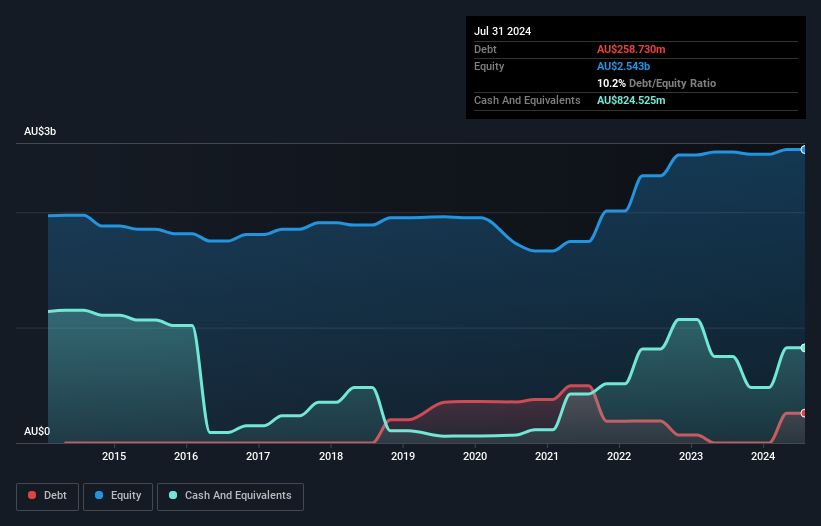The external fund manager backed by Berkshire Hathaway's Charlie Munger, Li Lu, makes no bones about it when he says 'The biggest investment risk is not the volatility of prices, but whether you will suffer a permanent loss of capital.' It's only natural to consider a company's balance sheet when you examine how risky it is, since debt is often involved when a business collapses. We note that New Hope Corporation Limited (ASX:NHC) does have debt on its balance sheet. But the more important question is: how much risk is that debt creating?
When Is Debt A Problem?
Debt is a tool to help businesses grow, but if a business is incapable of paying off its lenders, then it exists at their mercy. Ultimately, if the company can't fulfill its legal obligations to repay debt, shareholders could walk away with nothing. While that is not too common, we often do see indebted companies permanently diluting shareholders because lenders force them to raise capital at a distressed price. Of course, debt can be an important tool in businesses, particularly capital heavy businesses. The first thing to do when considering how much debt a business uses is to look at its cash and debt together.
View our latest analysis for New Hope
How Much Debt Does New Hope Carry?
The image below, which you can click on for greater detail, shows that at July 2024 New Hope had debt of AU$258.7m, up from none in one year. However, it does have AU$824.5m in cash offsetting this, leading to net cash of AU$565.8m.

A Look At New Hope's Liabilities
The latest balance sheet data shows that New Hope had liabilities of AU$614.7m due within a year, and liabilities of AU$310.7m falling due after that. Offsetting these obligations, it had cash of AU$824.5m as well as receivables valued at AU$146.7m due within 12 months. So it can boast AU$45.8m more liquid assets than total liabilities.
Having regard to New Hope's size, it seems that its liquid assets are well balanced with its total liabilities. So while it's hard to imagine that the AU$4.12b company is struggling for cash, we still think it's worth monitoring its balance sheet. Simply put, the fact that New Hope has more cash than debt is arguably a good indication that it can manage its debt safely.
The modesty of its debt load may become crucial for New Hope if management cannot prevent a repeat of the 57% cut to EBIT over the last year. Falling earnings (if the trend continues) could eventually make even modest debt quite risky. There's no doubt that we learn most about debt from the balance sheet. But it is future earnings, more than anything, that will determine New Hope's ability to maintain a healthy balance sheet going forward. So if you want to see what the professionals think, you might find this free report on analyst profit forecasts to be interesting.
Finally, while the tax-man may adore accounting profits, lenders only accept cold hard cash. While New Hope has net cash on its balance sheet, it's still worth taking a look at its ability to convert earnings before interest and tax (EBIT) to free cash flow, to help us understand how quickly it is building (or eroding) that cash balance. Over the most recent three years, New Hope recorded free cash flow worth 71% of its EBIT, which is around normal, given free cash flow excludes interest and tax. This free cash flow puts the company in a good position to pay down debt, when appropriate.
Summing Up
While we empathize with investors who find debt concerning, you should keep in mind that New Hope has net cash of AU$565.8m, as well as more liquid assets than liabilities. And it impressed us with free cash flow of AU$290m, being 71% of its EBIT. So we don't have any problem with New Hope's use of debt. The balance sheet is clearly the area to focus on when you are analysing debt. But ultimately, every company can contain risks that exist outside of the balance sheet. Case in point: We've spotted 2 warning signs for New Hope you should be aware of.
Of course, if you're the type of investor who prefers buying stocks without the burden of debt, then don't hesitate to discover our exclusive list of net cash growth stocks, today.
Valuation is complex, but we're here to simplify it.
Discover if New Hope might be undervalued or overvalued with our detailed analysis, featuring fair value estimates, potential risks, dividends, insider trades, and its financial condition.
Access Free AnalysisHave feedback on this article? Concerned about the content? Get in touch with us directly. Alternatively, email editorial-team (at) simplywallst.com.
This article by Simply Wall St is general in nature. We provide commentary based on historical data and analyst forecasts only using an unbiased methodology and our articles are not intended to be financial advice. It does not constitute a recommendation to buy or sell any stock, and does not take account of your objectives, or your financial situation. We aim to bring you long-term focused analysis driven by fundamental data. Note that our analysis may not factor in the latest price-sensitive company announcements or qualitative material. Simply Wall St has no position in any stocks mentioned.
About ASX:NHC
Flawless balance sheet, undervalued and pays a dividend.
Similar Companies
Market Insights
Community Narratives



